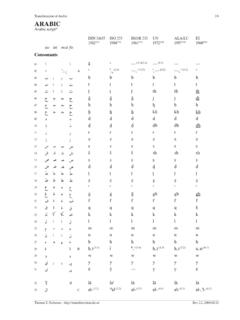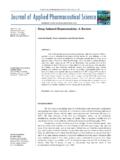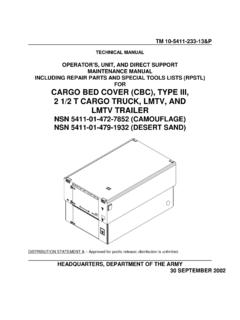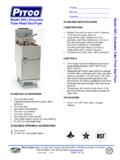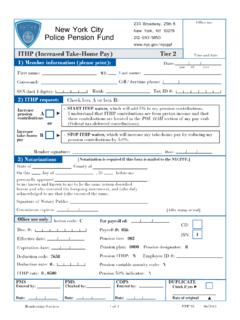Transcription of 2. The case-study For example, individual health …
1 2. The case-study approachFor example , individual health workers may respond differently to the same set of incentives; and patients vary in their response to treatment , as the examples of motivation and health seeking Lucy Gilsonbehaviours show, HPSR questions often require study of University of Cape Town, South Africa and London School the complex behaviours of, and relationships among, of Hygiene and Tropical Medicine, United Kingdom of actors and agencies; and how those relationships influence Great Britain and Northern Irelandchange, including change over time. The case-study approach is particularly relevant to such experiences The case-study approach is a research strategy entailing (Thomas, 1998).an empirical investigation of a contemporary phenome-non within its real life context using multiple sources of Third, as discussed in Part 2 of the Reader, the case-study evidence, and is especially valuable when the boundaries approach can be used both to support and analyse policy between the phenomenon and context are blurred development: it can generate information for policy (for (Yin, 2009).)
2 It is widely used in research fields and example see Rolfe et al., 2008 in this section) or be used to disciplines of relevance to HPSR, such as political science, analyse past policy experiences in detail (see, for example , public administration, planning studies, organizational Shiffman, Stanton & Salazar, 2004 in this section).and management studies, community psychology and case-study work is also very flexible. In terms of overarching purposes (see Part 2: Step 2), it can:There are three main reasons why this research approach support exploratory inquiry to gain a better under-is particularly relevant to HPSR. First, health policy and standing of certain situations or to generate ideas and systems experience is strongly influenced by, and is often concepts for use in follow-up work;embedded in, contextual factors that must themselves allow detailed description of particular experiences;become part of the focus of inquiry (Gilson et al.
3 2011). enable the investigation of how and why explanatory For example , health worker motivation is influenced by a questions, supporting analytic generalization through range of personal, organizational and societal factors, as cross-case analysis (see Part 1: Section 7);well as relationships with others; and, in turn, many be used as a study approach in emancipatory work, such aspects of the provision of health care are influenced by as action research and participatory motivation of health workers (Franco, Bennett & Finally, case-study work can involve either single cases Kanfer, 2002). Similarly, patients decisions to use (of health policies, for example ) or a number of individual services or adhere to treatment advice represent cases of the same type (a case-study of different health responses to many influences, such as:facilities, for example ), or an embedded case approach, their own understandings of illness, and how best to where one type of case is nested within a broader case or treat itencompasses other cases.
4 An example of the latter would advice received from friends and familybe the case of a single health policy process that is inves-past experience of health providerstigated by examining the overall process and experience at the availability of cash to cover costsa number of case-study sites within the health system (such the gender dynamics influencing household decision-as regions, districts, and/or facilities); or the case of a health care facility that is recognized as nested in a district health system, requiring investigation of the case at On any health policy and systems issue there are also both interpretations of the same experience as different people bring their own contexts to bear on its interpretation. nnnnnnnnnPart 4 - Empirical Papers 161 The range of cases , the unit of focus, relevant to and an overview of procedures within the different phases considered in HPSR, therefore, is quite varied.
5 It includes of case-study work that help to ensure trustworthiness (Robson, 2002; Thomas, 1998; Gilson & Raphaely, 2008):(see also Gilson et al., 2011). individuals , communities, social groups, organizations;Given the areas of weakness in the current body of HPSR events, relationships, roles, processes, decisions, parti-work (Gilson & Raphaely, 2008), key areas that require cular policies, specific policy development processes, attention in future case-study research in the field research studies;include: health system decision-making units, particular health -the use of theory to support and enable analysis care facilities, particular selection to support analysiscase contextualization, especially in single cases in studies with multiple cases, comparative analytical strategies that support analytic general terms, the rigour of case-study work is secured These issues are discussed further below, in relation to by full reporting on the methods of data collection and the papers selected for this , so that readers can assess whether the analysis and interpretation is credible.
6 As discussed in Part 2: Readers are also encouraged to review available texts Step 3, the judgement of credibility is, in essence, one of (for example Yin, 2009; Thomas, 1998) on good case-whether the research procedures suggest that the study practice to strengthen HPSR case-study derived are trustworthy. Table 10 provides nnnnnnnRigour in case-study workCriterion of trustworthinessCase- study tacticConfirmability Conduct literature review, identify key concepts Use multiple sources of evidence Establish chain of evidence Ask key informants to review draft research report (member checking)Research designData collectionWrite up of analysisTable 10 Procedures to ensure trustworthiness in case-study research (Source: Yin, 2009)Phase of researchDependability Develop case-study protocol (so that others can see the decisions made indeveloping the study , and why you made them) Develop case-study database (complete set of data, that others could review)Data collectionCredibility Look for patterns in data and across cases (pattern matching) Consider explanations for experiences analysed (explanation building) Consider rival explanations (alternative explanations for the patterns identified) Use logic models to think through causal mechanisms Triangulation compare and contrast data across respondents, data sources,data types and cases Consider negative cases (explicitly seek out experiences that contradict your main line of argument, to test that argument and refine it)Data analysisTransferability Use theory in single case studies Use replication logic in multiple case studies (test ideas from one case against subsequent cases)
7 Research design Gilson L, ed. (2012). health Policy and Systems Research: A Methodology ReaderAlliance for health Policy and Systems Research, World health Organization162 ReferencesOverview of selected papersGilson L, Raphaely N (2008). The terrain of health policy The papers included in this section were chosen to analysis in low- and middle-income countries: a review of address a range of issues related to health policy and published literature 1994 2007. health Policy and systems and to show the different cases that can be Planning, 23(5):294 in HPSR case-study work, as shown et al. (2000) examine experiences of Brazi-Gilson L et al. (2011). Building the field of health Policy lian decentralization in three local settings, seeking to and Systems Research: Social Science Matters. PLoS understand the ways in which the contextual features Medicine 8(8) social organization and political culture influence these LM, Bennett S, Kanfer R (2002).
8 health sector Murray & Elston (2005) examine the single case of reform and public sector health worker motivation: a obstetric care in Chile, to understand the influence of conceptual framework. Social Science & Medicine, a macro level intervention (privatization in both 54(8):1255 and provision of care) over health system organization (meso level) and clinical practice (micro Robson C (2002). Real world research: a resource for level).social scientists and practitioner-researchers, 2nd ed. Mutemwa (2005) examines multiple cases of district Oxford, Blackwell Publishing:3 decision-making in the context of Zambian decentralization and in relation to information Thomas A (1998). Challenging cases. In: Chataway J, M, eds. Finding out fast: investigative skills for Rolfe et al. (2008) document and categorise the policy and development. London, Sage Publications: existing experience of private midwifery care across 307 districts in the United Republic of Tanzania, to generate information to guide future regulatory Yin RK (2009).
9 Case study research: design and methods, policy ed. Thousand Oaks, California, Sage & Gilson (2006) examine, across multiple households, the consequences of health care seeking behaviour for the economic situation, or livelihoods, of households in a low-income Sri Lankan community and the factors influencing this , Stanton & Salazar (2004) examine the single case of the safe motherhood policy in Honduras to understand how and why this policy became a political most papers primarily draw on qualitative data, Russell & Gilson (2006) report a mixed-method study (see also cross-sectional papers) in which an initial structured cross-sectional household survey, repre-sentative of the local community, generated findings that provided an overview of household experiences related to the key concerns of the study and the basis for more detailed qualitative work. The survey was specifically used to inform the selection of a small number of household cases for inclusion in a second phase of work, in which detailed understanding of the households nnnnnnPart 4 - Empirical Papers 163experiences was generated through application of Contextualization.
10 All descriptive and explanatory case multiple data collection methods (a combination of study work requires thick description , that is, interpre-qualitative and quantitative data). The analysis also tation of the phenomenon of focus by reference to con-combines data from both phases of the features (see the section on the ethnographic lens; also see Atkinson et al. 2000; Murray & Elston, These papers also offer insights into rigorous practice for 2005; Russell & Gilson, 2006; Shiffman, Stanton & case-study work, in relation to the four key current areas Salazar, 2004);of weakness in HPSR case-study work, as outlined and generalization. Rich analysis of context, The use of theory. Exploratory and descriptive case-as well as clarification of conflicting perspectives and study work may build theory as the basis for more interpretations of different actors, is particularly impor-detailed, future inquiry into the issue of focus (see tant in single-case studies as the value of such work lies Mutemwa, 2005).










